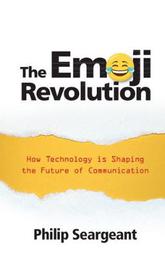
|
The Emoji Revolution: How Technology is Shaping the Future of Communication
Hardback
Main Details
| Title |
The Emoji Revolution: How Technology is Shaping the Future of Communication
|
| Authors and Contributors |
By (author) Philip Seargeant
|
| Physical Properties |
| Format:Hardback | | Pages:238 | | Dimensions(mm): Height 223,Width 143 |
|
| Category/Genre | Language - history and general works
Sociolinguistics |
|---|
| ISBN/Barcode |
9781108496643
|
| Classifications | Dewey:302.231 |
|---|
| Audience | | Professional & Vocational | | General | |
|---|
| Illustrations |
Worked examples or Exercises; 1 Halftones, black and white; 3 Line drawings, black and white
|
|
Publishing Details |
| Publisher |
Cambridge University Press
|
| Imprint |
Cambridge University Press
|
| Publication Date |
11 July 2019 |
| Publication Country |
United Kingdom
|
Description
Where have emoji come from? Why are they so popular? What do they tell us about the technology-enhanced state of modern society? Far from simply being an amusing set of colourful little symbols, emoji are in the front line of a revolution in the way we communicate. As a form of global, image-based communication, they're a perfect example of the ingenuity and creativity at the heart of human interaction. But they're also a parable for the way that consumerism now permeates all parts of our daily existence, taking a controlling interest even in the language we use; and of how technology is becoming ever more entangled in our everyday lives. So how will this split-identity affect the way that online communication develops? Are emoji ushering in a bold new era of empathy and emotional engagement on the internet? Or are they a first sign that we're handing over the future of human interaction to the machines?
Author Biography
Philip Seargeant is the author of several books on topics ranging from language and social media, linguistic creativity, to English around the world. His most recent work focuses on language, communication and politics, and the influence and impact on this of new technologies.
Reviews'Emoji are a significant development in contemporary communication, deserving serious attention for their impact on both language use and society. The book comes at them from a variety of complementary angles, elucidating their specific nature and function while simultaneously showing how they reflect and influence important developments in the modern globalised world. This insightful integration of the general and the specific places this book among the very best academic work in the field.' Guy Cook, Emeritus Professor of Language in Education, King's College London 'The Emoji Revolution is required reading for anyone with interest in emoji, or communication in general. While the subject matter might seem trivial on the surface, Philip Seargeant takes emoji and its impact very seriously in his book by rigorously examining the historical, political and social contexts of emoji use. Seargeant has produced a tremendous work of scholarship that is also a fun and engaging to read.' Jane Solomon, author of The Dictionary of Difficult Words 'In his book, The Emoji Revolution, Philip Seargeant argues that emojis have become a powerful new way of getting a message across - not just for young people, but for everyone. He provides a fresh perspective on these pictograms and challenges us to think beyond their silliness or simplicity.' Forbes 'The Emoji Revolution adeptly establishes emoji within a broader legacy of language and communication systems. The book is written in a highly engaging style that is peppered with Seargeant's wit and observational humor. The absence of jargon and extensive technical language makes this an accessible text which will appeal to lay audiences, academics, and student readers in a number of humanities and social science disciplines.' Miriam E. Sweeney, New Media and Society 'There is an element of fun and lightness throughout the narrative. However, the topic's overall treatment is serious and scholarly, so we find a mix of serious and fun, and a bit of the best of both worlds.' Jeanette Evans, Technical Communication
|